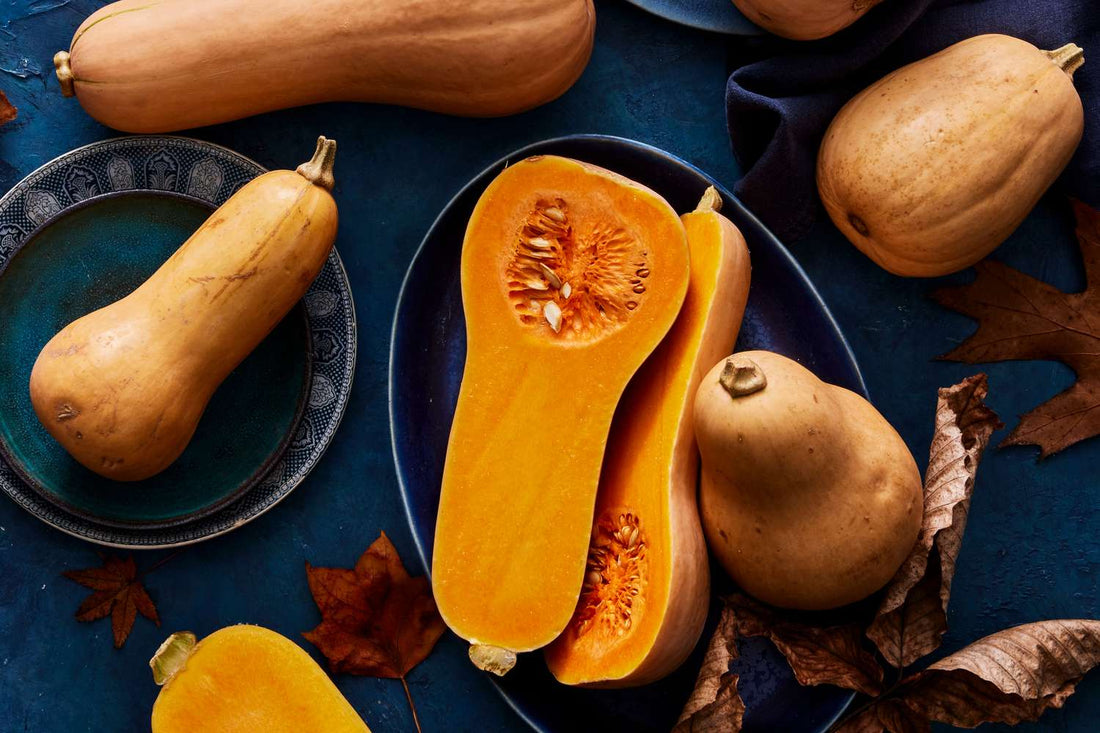Butternut squash - sounds yummy, right? but there's more to this dish than just deliciousness. it's packed with goodness for your heart, eyes, and lungs! let's dive in:
Nutritional value of butternut squash
Butternut squash or butternut pumpkin is a delicious and nutritious snack for long winter nights. Squash contains beta-carotene and vitamin C, both of which are effective for strengthening the immune system. The orange color of squash indicates its richness in beta-carotene, similar to carrots.
The vitamin C in this dish helps prevent colds and coughs, while the beta-carotene present in squash stimulates the production of white blood cells, aiding in reducing bacterial infections. Cook and consume butternut squash during this season to recover more quickly.
Given its highly potent antioxidant properties, this plant is the most suitable nutrition for individuals suffering from colds and flu. If you have a cold, it aids in soothing the throat. This remarkable plant, in addition to its antioxidant properties, is rich in vitamins A, C, and E, and serves as a good source of flavonoid polyphenolic compounds such as beta-carotene and alpha-carotene. It also contains B-complex vitamins like folates, niacin, B6, thiamine, and pantothenic acid.
In addition to these vitamins, squash contains significant amounts of minerals such as copper, calcium, potassium, and phosphorus, all of which are crucial for overall body health. Another benefit of squash is the presence of beta-cryptoxanthin and carotenoids, making it highly suitable and beneficial for health.
The edible parts of butternut squash include: the fruit, skin, and seeds. The flowers of the squash can also be eaten, but they are typically used for making pickles, jams, or oil.

Heart-healthy hero
Butternut squash offers heart health benefits. Research from Harvard University suggests that the fiber present in squash contributes to a healthy heart and lowers the risk of cardiovascular diseases.
Eye-opening goodness
Carotenoids and beta-carotene, found in sweet butternut squash, support eye health and enhance vision, reducing the risk of eye diseases. The presence of these compounds, along with vitamins E and C, helps decrease the risk of macular degeneration.
Squash and men's sexual vitality
Researchers, as part of their ongoing exploration in medical advancements, have discovered that the zinc in squash elevates testosterone levels in men, effectively treating sexual dysfunction and fertility issues in males.
Lung-loving nutrients
Consuming 35 grams of raw squash seed kernel per day is beneficial for treating lung bleeding. Among its remarkable properties, it helps prevent various types of cancers, especially for smokers at risk of lung cancer. Other exceptional benefits include reducing asthma attacks, preventing stomach ulcers, and promoting hair growth and strength.
Here are some other potential health benefits of squash:
- Reducing asthma attacks
- Anticancer properties
- Preventing stomach ulcers
- Promoting skin health
- Stress reduction
- Strengthening and promoting hair growth
- Assisting in treating hair loss
- Hair conditioner
- Boosting the immune system
- Relieving cough
- Alleviating joint pain and arthritis
- Easing constipation
- Kidney stone dissolver
- Hepatitis treatment

Butternut Squash Dish Recipe
Boiling squash in a pot or baking it in the oven are two common techniques for crafting squash delights. Abundant in benefits, butternut squash is incorporated into diverse dishes, desserts, and cake recipes. This fruit is readily found in abundance during autumn and winter, allowing for versatile cooking approaches. In the subsequent section, we will elaborate on these two cooking methods.
How to cook squash
Step One: To prepare a delightful and very tasty squash dish, start by acquiring suitable squashes. It is recommended to choose sweet squashes with a fully orange color to enhance the likelihood of sweetness.
Step Two: In this step, chop the squash into pieces approximately half the size of your palm and arrange them in the bottom of a large, wide pan. Note that there's no need to peel the sweet squash before cooking.
Step Three: Another aspect to consider when arranging the squash pieces in the pan is to have the squash skins facing upward, with the fruit's flesh on the pan's surface. Using a large pan is recommended to avoid the squashes overlapping.
Step Four: In this stage, add enough water so that its level is one finger joint higher than the surface of the squashes. Next, add grape molasses, and then evenly sprinkle brown sugar over the sweet squash pieces.
Step Five: Now, place the pan over high heat to bring the water to a boil. Then, reduce the heat, cover the pan, and let the squash simmer for half an hour. After this time, remove the lid from the pan.
Step Six: In this stage, allow an additional 30 minutes for the water inside the pan to completely evaporate, leaving a caramel-like sauce at the bottom of the pan. In the final 5 minutes, add a bit of cinnamon and cardamom. Finally, transfer the squash to your desired dish and serve.

Fried Squash Recipe
- Choose a full and fleshy orange squash.
- Peel the squash and cut it into suitable pieces.
- Melt some butter in a pan and sauté the butternut squash pieces until slightly brown.
- Sprinkle cinnamon and cardamom powder over the squashes.
- Sprinkle sugar on top of the butternut squash.
- Flip the squashes over so that the sugar slowly starts to melt.
- Pour steeped saffron over the squashes for a delightful color.
- Pour a bit of water over the squashes, ensuring the water level is one finger joint higher than the squash surface.
- Close the pan with a lid, place it on low heat, and let it simmer for half an hour.
- Remove the lid and let the squash boil for an additional 30 minutes in an uncovered pan, allowing the water to completely evaporate, leaving a thick syrup at the bottom.
- Finally, transfer the sweet fried squash to your desired dish and serve.

Steamed Squash Recipe
Step One: To make steamed squash, first clean and dry the outer part of the squash. Then, using a sharp knife, carefully cut the tough skin. Note that the squash skin is firm. Half-fill a pot with water.
Step Two: Place the pot on the stove until the water boils, then reduce the heat and put a steamer inside the pot. The steamer should not touch the water directly but remain on the pot's edge without coming into contact with the water.
Step Three: Place the chopped squash pieces into the steamer, close the pot's lid, and steam for about a quarter of an hour until the squash is fully cooked. Remove from heat and arrange in a serving dish. Add steeped saffron, cardamom powder, and cinnamon. Sweeten with honey and garnish with pistachio powder and coconut powder.

Squash Dessert Recipe
Ingredients:
- Butternut squash: One kilogram
- Honey: Three tablespoons
- Green cardamom powder: One pinch
- Rosewater: Four tablespoons
- Saffron powder: Two grams
- Mixture of chopped pistachios, almonds, and coconut powder: Four tablespoons on top of each other.
Recipe:
- Start by cutting the squash into suitable pieces, then steam them and later mash them.
- Add honey, rosewater, saffron, and cardamom powder to the mashed squash, and thoroughly mix.
- While mixing, gradually add two tablespoons of the mixture of chopped pistachios, almonds, and coconut powder.
- Shake the container to even out the surface and refrigerate it for a few hours to set.
- This dessert is highly beneficial for joint and eye conditions.

Squash Cake Recipe
Ingredients:
- Squash puree: 2 cups
- Flour: 3 cups
- Sugar: 1 and 1/4 cups
- Eggs: 4
- Milk: 1/2 cup
- Liquid oil: 1 cup
- Vanilla: 1 tablespoon
- Baking powder: 1 tablespoon
- Cardamom powder : 1 teaspoon
- Cinnamon and ginger powder: 1/2 teaspoon each
Recipe:
- Begin by chopping the squash, removing the squash seeds, and separating the squash flesh from its skin. Place the squash flesh in a food processor or blender, mix until smooth, and set aside.
- Choose a suitable bowl and add eggs, sugar, and vanilla. Use an electric mixer on high speed for 5 to 10 minutes until the egg mixture is white and fluffy.
- In this stage, add oil along with milk to the egg mixture. Mix with an electric mixer for 1 minute until the ingredients are well combined and uniform.
- Choose another suitable bowl, then add flour and baking powder. Mix, and sift then twice. In this step, add the sifted flour and baking powder mixture in three stages to the egg mixture. Continue mixing with a spatula in a circular motion until well combined.
- Finally, add two cups of chopped squash to the mixture and combine using a spatula.
- Preheat the oven to 180 degrees Celsius and allow it to fully preheat. Choose a suitable mold, grease it with a mixture of butter and flour.
- Pour the cake batter into the prepared mold (preferably using a center-empty Cake Mold) and tap the mold firmly on the countertop several times to remove excess air between the batter and bubbles. Then, place the cake mold on the middle rack of the preheated oven.
- After 45 minutes, perform the toothpick test. If the toothpick comes out clean, remove the cake from the oven and let it cool. Take the cake out of the mold and place it in the desired dish.

Important Tips for Cooking Squash
- To enhance the aroma of squash, add a little rose water at the end.
- Instead of cinnamon and cardamom powder, you can use cinnamon sticks and cardamom pods for added flavor.
- Avoid adding excessive water to prevent the squash from becoming overly watery.
- To make peeling easier, consider steaming the squash slightly before peeling.
- For added sweetness, you can use grape syrup during cooking or honey after cooking.



